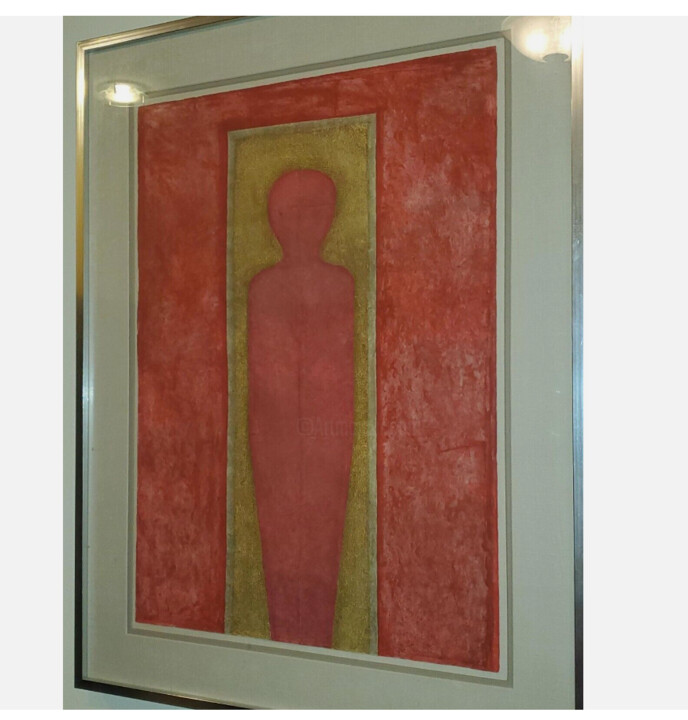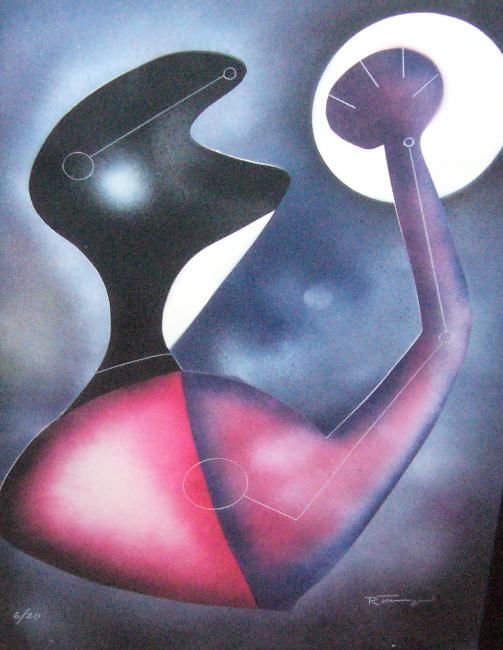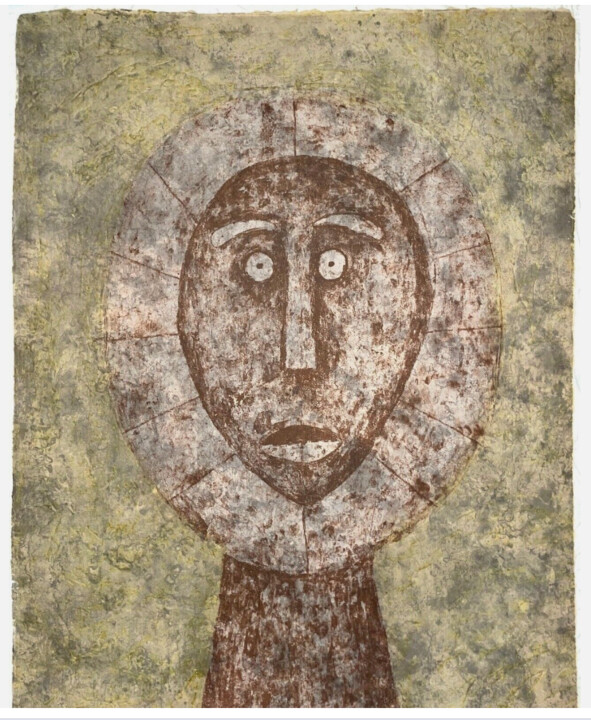Rufino Tamayo, a renowned Mexican painter and printmaker, is celebrated for his large-scale murals and vibrant colors. Influenced by modern movements like cubism and surrealism, Tamayo integrated Mexican motifs into his figurative paintings. Born on August 26, 1899, in Oaxaca, he left the San Carlos Academy early to pursue his own artistic path. Settling in New York in the 1930s after conflicts with Mexican activist artists, Tamayo gained international acclaim. His works are exhibited in prestigious museums worldwide, including New York's Museum of Modern Art and Madrid's Museo Nacional Centro de Arte Reina Sofia. Tamayo returned to Mexico in 1959 and passed away on June 24, 1991, in Mexico City at the age of 91. His legacy is honored through institutions like the Museo Tamayo Arte Contemporáneo and the Museo Rufino Tamayo, which preserves his pre-Columbian art collection in his hometown.
Artist Biography: Rufino Tamayo
Rufino Tamayo, born in 1899 in Oaxaca, Mexico, emerged as a pivotal figure in 20th-century Mexican art, renowned for his distinctive style and profound cultural insight. Raised in a humble background after his mother’s early death, Tamayo's early life was deeply influenced by his Zapotec heritage and the vibrant markets of Mexico City, where he moved to live with his aunt. Despite helping with the family business, his passion for art led him to enroll at the Escuela Nacional de Artes Plásticas at San Carlos in 1917, marking the beginning of his formal artistic journey. As a student, Tamayo explored various artistic movements including Cubism, Impressionism, and Fauvism, yet he always maintained a uniquely Mexican perspective in his work. His divergence from the politically charged muralist movement of Rivera, Orozco, and Siqueiros reflected his belief that art should transcend politics, embodying a deeper, more personal expression of Mexican identity. This conviction, evident in seminal works like "Niños Jugando con Fuego" (Children Playing with Fire), underscored Tamayo's concern for humanity's existential dilemmas and the consequences of its own actions.
In 1926, seeking greater artistic freedom, Tamayo moved to New York City, where he garnered attention for his individualistic approach. His time in New York exposed him to European modernist influences and facilitated significant exhibitions, elevating his international profile. Despite this, Tamayo maintained strong ties to Mexico, returning periodically for exhibitions that received critical acclaim. His engagement with printmaking, particularly through his collaboration with Luis Remba in developing the Mixografia technique, further expanded his artistic horizons, allowing him to imbue his prints with rich textures and depth. The 1940s saw Tamayo navigate a period of heightened political scrutiny in Mexico, prompting a move to Paris with his wife Olga. Here, his focus on introspective themes and humanistic concerns continued to evolve, exemplified by works that explored universal emotions through a distinctly modern lens. Returning permanently to Mexico in 1959, Tamayo cemented his legacy by establishing the Museo Rufino Tamayo in Oaxaca, a testament to his commitment to fostering art appreciation and education.
Throughout his illustrious career, Tamayo’s art resonated globally, exhibited in prestigious museums from the Guggenheim in New York to the Museo Nacional Centro de Arte Reina Sofía in Madrid. His final years were marked by prolific creativity, with Tamayo continuing to produce significant works until his passing in 1991. Today, his legacy endures not only through his art but also through the institutions he founded, ensuring that future generations continue to appreciate and contemplate the profound contributions of one of Mexico's most influential modern artists.
Style
Tamayo's artistic style is distinguished by a harmonious blend of influences that reflect both his Mexican heritage and his engagement with global artistic currents. Rooted deeply in his cultural identity, Tamayo's work stands out for its unique approach to color and form, embodying a blend of indigenous Mexican traditions with modernist sensibilities. Influenced by fellow Mexican artist María Izquierdo and his own profound appreciation for Mexico's ethnic diversity, Tamayo meticulously selected colors that resonated with the vivid landscapes and rich cultural tapestry of his homeland. Rejecting the notion of a "gay race" in favor of a more tragic and introspective interpretation, Tamayo believed in capturing the essence of Mexican life through nuanced color palettes that reflected deeper emotional and cultural narratives.
His paintings, such as Lion and Horse (1942), often integrated elements of pre-Columbian ceramics, showcasing his admiration for Mexico's pre-Hispanic heritage. This fusion of indigenous and European influences was not just a stylistic choice but a thematic exploration of Mexico's complex cultural identity, celebrating its diversity as a source of strength and inspiration. Tamayo's style is characterized by his deliberate use of color. Emphasizing quality over quantity, he famously asserted that limiting the number of colors in a painting enhanced its expressive power. Works like Three Singers (1981) exemplify this approach with their bold, pure colors—red, purple, and others—each carefully chosen to convey emotional intensity and visual impact. This restraint in color choice, far from constraining his art, enabled Tamayo to explore the depths of human emotion and the vibrancy of Mexican culture more profoundly.
Nobel Prize-winning poet Octavio Paz aptly described Tamayo's mastery of color as a form of "sober richness," where each hue, though pure, contributes to a nuanced and layered visual experience. Tamayo's paintings, whether explicitly depicting the sun or not, radiate with a luminosity and warmth that symbolize his deep connection to Mexico's natural landscapes and spiritual heritage.
Cabeza en Gris (1979) by Rufino Tamayo
Rufino Tamayo, Cabeza en Gris, 1979. Printmaking, Etching on Paper, 76cm x 56cm.
Cabeza en Gris (1979) by Rufino Tamayo is a compelling example of his mastery in printmaking, specifically in etching on paper. This limited edition print, numbered 1 out of 99, exemplifies Tamayo's pioneering role in Mexican graphics, particularly through his innovative use of color and texture. The artwork portrays a tribal figure, rendered with Tamayo's characteristic blend of abstraction and cultural symbolism. Despite its title suggesting grayscale, "Cabeza en Gris" surprises with its subtle yet intricate play of hues, possibly hinting at muted tones that highlight the figure's form and expression. Tamayo's exploration of polychrome lithographs earlier in his career informs this piece, where his meticulous attention to color nuances adds depth and emotive resonance to the subject.
The texture of the etching process itself becomes part of the artwork's allure, contributing tactile qualities that invite closer inspection. Through delicate lines and subtle shading, Tamayo captures not just the physical features of the tribal figure but also imbues it with a sense of spirituality or cultural significance. The composition likely emphasizes simplicity in form, contrasting with the complexity of Tamayo's color palette, thereby enhancing the artwork's visual impact and symbolic depth. Overall, Cabeza en Gris exemplifies Rufino Tamayo's enduring influence in Mexican art, showcasing his ability to merge traditional elements with modernist techniques to create works that resonate both aesthetically and culturally. Through this print, Tamayo invites viewers into a world where ancient traditions meet contemporary artistic expression, making it a significant piece in the canon of Mexican printmaking.
Figura de Pie (1977) by Rufino Tamayo
Rufino Tamayo, Figura de Pie, 1977. Printmaking, Lithography on Paper, 27cm x 27cm.
Figura de Pie (1977) by Rufino Tamayo is a captivating lithograph that showcases his distinctive approach to color, form, and symbolism. This limited edition print, one of only 100 copies, exemplifies Tamayo's mastery in printmaking and his ability to create visually compelling compositions that resonate with cultural and emotional depth. The artwork features a framed depiction of a human figure, standing upright and rendered in a bold red hue. This central figure is set within a gold rectangle, creating a striking contrast against the deep red background. The use of color here is deliberate and evocative, with red symbolizing vitality, passion, or perhaps even a sense of urgency or presence. Surrounding the gold-framed figure is another red rectangle, which adds layers of visual complexity and depth to the composition. The arrangement of shapes and colors suggests a play of light and shadow, reminiscent of a doorway or a keyhole, inviting viewers to contemplate what lies beyond or within.
Tamayo's use of lithography on paper enhances the artwork's texture and visual impact, allowing for precise lines and subtle tonal variations that contribute to the overall mood and atmosphere. The simplicity of the composition belies its depth, inviting viewers to interpret the framed figure not just as a physical form but as a metaphorical representation of human presence, identity, or passage. In Figura de Pie, Rufino Tamayo demonstrates his ability to blend abstraction with recognizable elements, creating a piece that is both enigmatic and accessible. The artwork's framed presentation and its suggestive use of shapes and colors encourage viewers to engage with themes of presence, perception, and the interplay between light and shadow. As a published original hand-signed mixograph, this print stands as a testament to Tamayo's enduring influence in Mexican art and his innovative contributions to the medium of printmaking.
Iconic Artwork
Among Rufino Tamayo's vast body of work, several artworks stand out as iconic representations of his artistic vision and thematic exploration. One of his early pieces, Children Playing with Fire (1947), symbolizes Tamayo's concern with human actions and their consequences. In this painting, two figures are depicted being burnt by a fire they have ignited, reflecting Tamayo's commentary on societal dangers and the potential self-destructiveness of humanity. Another significant work is Nacimiento de nuestra nacionalidad (Birth of Our Nationality, 1952), housed within Mexico City's Palacio de Bellas Artes. This mural exemplifies Tamayo's ability to merge modernist aesthetics with Mexican cultural themes. The painting portrays the birth of Mexican identity through a dynamic composition that incorporates indigenous symbolism and vibrant colors, reflecting Tamayo's pride in his cultural heritage. Tamayo's El día y la noche (Day and Night, 1954) further illustrates his mastery of color and form. This diptych contrasts vividly colored representations of day and night, showcasing Tamayo's ability to evoke mood and atmosphere through his distinctive use of hues. Each panel exudes a sense of balance and harmony, symbolizing the cyclical nature of existence while emphasizing the artist's fascination with cosmic themes. In Tres personajes cantando (Three Singers, 1981), Tamayo explores themes of music and performance through a composition that is both lively and evocative. The painting features three figures engaged in song, rendered with bold, pure colors that highlight their expressive gestures and interactions. Tamayo's minimalist approach to color in this artwork enhances its emotional impact, underscoring his belief in the power of simplicity to convey profound human experiences. Finally, Luna y Sol (Moon and Sun, 1990), created near the end of Tamayo's prolific career, encapsulates his enduring fascination with celestial bodies and their symbolic meanings. This painting, characterized by its symbolic use of light and dark, reflects Tamayo's contemplation of universal themes and his ongoing exploration of the natural world's mysteries.
Exhibition History
Rufino Tamayo's solo exhibition history is a testament to his prolific career and enduring influence on modern art, spanning from his early showcases in Mexico City and New York to prestigious international venues across several decades. His first solo exhibitions in 1926 at Pasaje América in Mexico City and Weyhe Gallery in New York marked the beginning of his journey as a recognized artist. Throughout the late 1920s and 1930s, Tamayo's work was featured prominently at venues such as The Art Center and John Levy Galleries in New York, and the Galería de Arte Moderno del Teatro Nacional (now Palacio de Bellas Artes) in Mexico City. Tamayo's international reputation flourished in the 1940s and 1950s with exhibitions at Catherine Kuh Gallery in Chicago, Galerie Beaux-Arts in Paris, and Instituto de Arte Moderno in Buenos Aires. His significant presence in the American art scene continued with exhibitions at Valentine Gallery in New York, the San Francisco Museum of Art, and the Santa Barbara Museum of Art. In the 1960s and 1970s, Tamayo's retrospectives and major exhibitions expanded globally, including notable shows at the Musée d’Art Moderne in Paris, the Phoenix Art Museum in Arizona, and the R. Guggenheim Museum in New York. His work was also celebrated in Latin America with exhibitions at Museo de Bellas Artes in Caracas and the Museo Nacional de Arte in El Salvador, reflecting his enduring influence and cultural resonance beyond North America and Europe. Tamayo's later years were marked by comprehensive retrospectives and anthological exhibitions, including significant showcases at the Museo Nacional Centro de Arte Reina Sofia in Madrid and the Modern Museum of Art in Woodland Hills, California. These exhibitions not only celebrated Tamayo's artistic evolution and mastery of color and form but also underscored his role as a pioneer in bridging indigenous Mexican motifs with modernist sensibilities.
In the colorful tapestry of Mexican modernist art, Rufino Tamayo emerges as a luminary, renowned for his bold innovation and profound cultural insight. Departing from the politically charged murals of his peers, Tamayo's canvases become vibrant celebrations of Mexico's rich heritage, blending indigenous motifs with a modernist sensibility. Works like "Nacimiento de nuestra nacionalidad" (Birth of Our Nationality) and "El día y la noche" (Day and Night) stand as testament to his mastery of color and form, capturing the essence of Mexico amidst a backdrop of societal transformation. Beyond his artistic endeavors, Tamayo's impact reverberates through cultural diplomacy and education, notably through institutions such as the Museo Rufino Tamayo in Oaxaca and the Tamayo Contemporary Art Museum in Mexico City. Honored with prestigious awards like the National Prize for Arts and Sciences in Fine Arts of Mexico, Tamayo's legacy endures as a beacon of creativity and national pride, inspiring generations with narratives of resilience and the enduring beauty of Mexican identity.




 Selena Mattei
Selena Mattei






